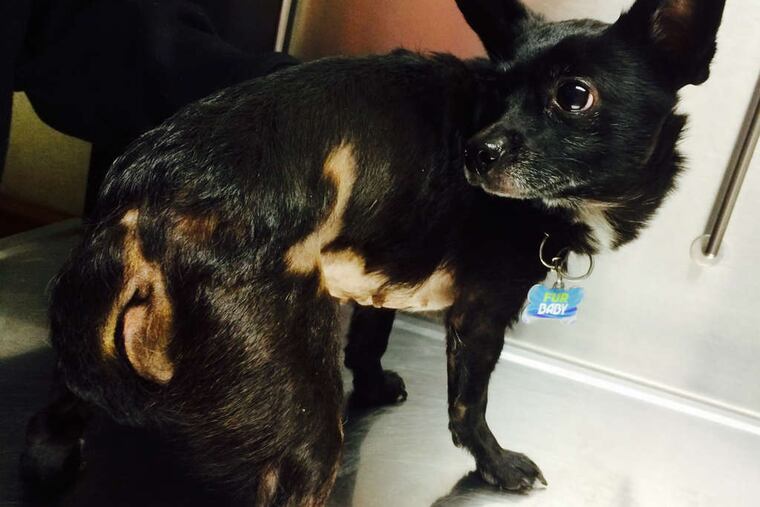What's causing changes, pain in Chihuahua?
Hyper yet affectionate, the 5-year-old Chihuahua loved to cuddle with his owners perhaps as much as he enjoyed playing.

Hyper yet affectionate, the 5-year-old Chihuahua loved to cuddle with his owners perhaps as much as he enjoyed playing.
Things changed in mid-November, when Max became sluggish and walked cautiously. He cried - as if in pain - whenever someone tried to pick him up, and when he defecated. His appetite was down.
"He had this look of sadness," recalled his owner, Christian Torres of Philadelphia.
Like most other male dogs, Max had always lifted his leg to urinate. But he had been squatting for a few months. His hair had been falling out since the summer. Then, a few weeks before his early December vet appointment, Torres noticed a lump in Max's groin; it seemed to have appeared suddenly.
The vet noted several disparate problems. Max's skin seemed to be thinning. He had large bald spots, mostly on his neck, sides, abdomen, and the base of his tail. Yet there were no fleas, a common cause of hair loss. Endocrine disorders such as hypothyroidism and Cushing's disease also can produce hair loss in dogs, but there were no other signs of these.
His nipples were enlarged - not quite as much as females that are pregnant, in heat, or had birthed pups, but noticeable. And his penis was shrunken, while the foreskin was swollen. A large mass bulged out of his right groin. When the vet palpated it, Max whined in pain.
Could it be a hernia?
Herniated tissue is usually soft, and often can be pushed back into the abdomen. Max's lump was solid and immoveable. The vet placed her stethoscope over the mass to listen for the gurgling sounds of herniated intestine. Silence.
Max's scrotum appeared to be empty: There was just a small, elongated, rubbery thickening rather than two healthy testicles. The vet asked whether the dog had been neutered.
Torres hadn't had Max neutered, and recently obtained a female Chihuahua that he hoped to breed with him. But he wasn't sure; Max was a year old when he got him.
Max's gums were pale and his heart was racing, both signs of anemia. By this point the vet was nearly certain of her diagnosis, but she ordered blood tests just in case. The results signaled damage to the bone marrow.
Max went in for exploratory surgery.
Solution
Max's exploratory procedure quickly shifted to real surgery.
Out of this small, black dog, the surgeon removed a mass the size of a lime - a purple, swollen, apparently cancerous, undescended testicle. Presumptive diagnosis (the owner declined a biopsy): Sertoli cell tumor.
Sertoli cell tumors secrete estrogen. The female hormone likely caused Max's penis to shrink and nipples to enlarge, and triggered the squatting behavior. The other symptoms fit as well.
Testicular tumors are not uncommon in dogs (toy breeds such as the Maltese, the Yorkshire terrier, and the Chihuahua are at higher risk) and people, but rare in cats.
In utero, the testicles develop deep in the abdomen, near the kidneys. When a puppy is born, they begin what typically is an eight-week journey down the inguinal canal and into the scrotal sac. Sometimes the process takes longer. A testicle that fails to descend by six months of age, a condition known as cryptorchidism, endures temperatures far higher than in its normal location and is 10 times as likely to develop tumors.
The estrogen secreted by Sertolis causes nearly half of afflicted dogs to experience male feminization syndrome. (In rare situations, the tumor develops in a female's ovary.)
In Max's case, it also explained the small, ropy nodule that the vet had felt in his otherwise empty scrotum. It was his other testicle, properly descended but then degenerated due to the hormone imbalance. It was removed during surgery.
Max's mass may have been growing slowly for years. It might have expanded suddenly due to internal bleeding, or perhaps got twisted and became inflamed.
Testicular tumors in dogs tend not to metastasize. When diagnosed, Sertolis carry about a one in seven chance of spread to regional lymph nodes and organs. Castration usually is sufficient treatment, although chemotherapy and radiation may benefit patients whose cancer has spread.
The effects of estrogen start to wane within weeks of the tumor's removal.
Today, Max is again lifting his leg to urinate. His shiny black coat is growing in.
Follow-up blood work will assess whether his bone marrow, which may have sustained permanent damage, has resumed normal blood cell manufacture. Vitamins and nutritional supplements can help support these added production demands.
Max will be monitored at home for any signs of cancer spread. His prognosis for a full life is cautiously optimistic.